CD Album – Jewel Case – 3 tracks
Design & photography by Jon Wozencroft
Premastering by Christian Fennesz
Mastering by Denis Blackham @ Skye
Tracklist:
1. part 1 – Unfinished – mellow 33:39
part 2 – Unfinished – waiting
part 3 – Unfinished – longing
2. Unfinished – sailing 16:44
3. Unfinished – ending 2:55
“The sun is God” (The last words of painter, JMW Turner)
“Which side of the picture should be hung uppermost? – 2003, London: the first time I visited Tate Britain, Tate Gallery, and the first time I saw and really experienced the paintings of JMW Turner (1775-1851). Overwhelmed, especially by his late and unfinished works I was stunned by the power of the stillness of his work. 25 years before that something similar; me, as a young man in Madrid; Prado, Goya paintings and etchings – for me an initiation which opened up the door to earlier art and its pioneers. Like Goya one generation before him, Turner is one of those artists whose language was becoming radicalized in the high age. (In the field of music he is the contemporary of Beethoven.) His later paintings transcend light, full of poetic imagination, exquisite liquid calm. Free pure painting – nothing as light, air and water. When I left the exhibition, it was clear to me that this visit was the starting point for my musical approach to his paintings. Over the years, it was a pleasent challenge to get closer and closer to the painter’s complex simplicity, transforming the enigmatic atmospheres of his late and unfinshed works into personal tempting musical soundscapes.” Burkhard Stangl, September 2013
Track notes:
#1 recorded live by Norbert Benesch at Porgy and Bess, Vienna, 4th January 2013
#2 recorded by Fennesz at Amann Studios, Vienna, 5th March 2013. First take, no edits, no cuts.
#3 recorded live by Philip Leitner, at Garnison7, Vienna, 18th June 2010
Burkhard Stangl: electric guitar and tapes (electronics and field recordings). Unfinished 1 (mellow) is based on Stangl’s composition for three zithers Mellow (My Feldman), dedicated to and played by Trio Greifer.
Reviews:
“Fantastic!” – BJNilsen
whisperinandhollerin (UK):
Astounded by seeing first hand the works of the master artist JMW Turner at the Tate gallery, London, Burkhard Stangl experienced something of an epiphany. Particularly taken by Turner’s late and unfinished works, the composer and musician took these pieces as the basis for the musical explorations that would, over the course of three years, become ‘Unfinished’. The album sets out to capture the essence of the ‘complex simplicity’ of the paintings. There is, without doubt, a ‘complex simplicity’ to these recordings.
Rich tones resonate in the prolonged spaces between each individual note. Yet in the background, there are distant sounds, voices and peripheral ephemera that form a backdrop like rain filling puddles. It’s all about the texture, the tone, the way in which notes hover in the air, the subtleties of sound functioning in the same way as brush strokes on a painting’s canvas.
The title – ‘Unfinished’ –suggests these pieces are but sketches, studies for a larger, major work. Yet as is often the case, the incomplete outlines, the works in progress are enlightening and reveal a great deal about the creative process, and as such form an integral part of any artistic corpus. That these pieces were recorded live, with ‘#2 Unfinished – Sailing’ recorded in a single take, and without overdubs or edits, means they have the spontaneity of draught works, which lends them a sense of immediacy and of freedom. The result is beautifully simple, and simply beautiful. [Christopher Nosnibor]
Reader (USA):
Austrian experimental guitarist Burkhard Stangl (Polwechsel) stumbled upon the work of 18th-century painter William Turner on his first visit to London’s Tate Gallery in 2003, and he says he was inspired by the artist’s work, especially some of his later, unfinished paintings. The three solo guitar pieces on Unfinished—elliptical, minimalist, and augmented with atmospheric field recordings—don’t directly address Turner’s art. Instead, these resonant meditations seem to correlate to what Stangl has described as the painter’s play with light, air, water, and stillness. Not much happens, but Stangle summons a gorgeous ambience, scuffed by seemingly inadvertent string scrapes—and the sounds shimmer and undulate as if adrift on the waves or buoyed by the breeze. [Peter Margasak]
Record Collector (UK):
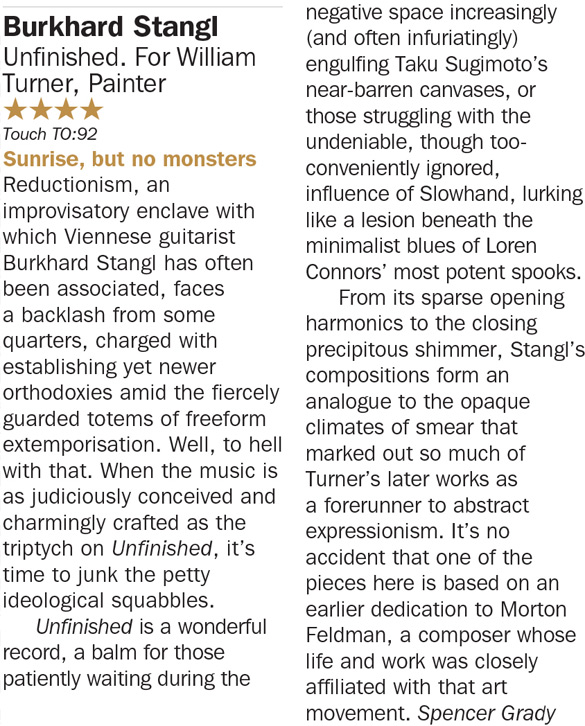
Texture (USA):
Attunement—something every listener must bring to each listening experience, and the principle applies especially well in the case of Burkhard Stangl’s Unfinished. For William Turner, painter. A bit of background first: upon viewing the paintings of JMW Turner (1775-1851) in 2003 at the Tate Gallery in London, Stangl found himself struck, overwhelmed even, by the power of stillness in the work—their “exquisite liquid calm,” as he calls it—and knew then that he would one day try to distill the painter’s “complex simplicity” into musical soundscapes. The fifty-three-minute recording presents three settings, all recorded live at different locations in Vienna (the first by Norbert Benesch at Porgy and Bess in 2013, the second by Fennesz at his Amann Studios in 2013, and the third by Philip Leitner at Garnison7 in 2010), that effectively document Stangl’s attempt to render the poetic vision of Turner into sonic form.
The opening piece, a three-part setting of thirty-four-minute duration, unfolds in such a restful manner and at such a laconic pace (it’s no surprise that its first part is titled “Unfinished – mellow”) that the listener naturally adjusts his/her normal listening tendencies to suit it. Time slows in the most welcome way as one surrenders to the lulling flow of Stangl’s electric guitar playing and electronics, with outdoors field recordings of nature sounds and children’s voices present as atmospheric augmentation. Though a shuddering drone acts as a steady undercurrent, the focal point is primarily Stangl’s guitar playing, which largely concentrates on strums, tremolo treatments, and textural effects, even if there are moments during the last quarter where the guitar briefly cedes the stage to the field recordings.
Half as long as the first piece, “Unfinished – sailing” perpetuates the unhurried spirit of the opener in a first-take performance that augments the vibrato-heavy strums and plucks of Stangl’s special-tuned Gibson SG with field recordings and instrumental air sounds. If anything, time slows even further in this piece, with liberal spaces separating the guitar phrases such that at times only a subdued drone is heard gently wavering in the background. The final piece, an unadorned solo guitar setting called “Unfinished – ending,” is dwarfed by the others in being a mere three minutes in length, though on its own terms it makes for a perfectly fine coda. Concise it is, yet in its own way the closer just as convincingly renders the peaceful calm of Turner’s imagery into aural form as do the longer ones.
Spin (USA):
Austrian Fennesz conspirator and guitar-harmonics enthusiast Burkhard Stangl patiently taps into all sorts of modern blissmaking: the new school of Fahey pluckers (he’s like William Tyler on lean), the current era of drone dungeon masters (he’s like Tim Hecker if he only saw Autumn afternoons), and the field recordings of the Touch crew (here he chases waterfalls, lets the wind blow).
Chain D.L.K. (USA):
A very interesting linkage between music and painting comes from Austrian jazz guitarist Burkhard Stangl, who rendered a sort of synaesthetic translation of wonderful works (particularly his last ones Burkhard admired at Tate Gallery in London) by Joseph Mallord William Turner, a water colourist and landscape painter, whose particular technique focuses on an astonishing use of light so that many critics considered him as the Romantic forerunner of Impressionism, even if his late works such as “Sunrise with Sea Monsters” or “Rain, Steam and Speed – The Great Western Railway” are closer to abstract and surreal art. According to his biography, Turner’s famous last words, which got quoted by Burkhard ‘s introduction to this release, were “the sun is God”, but I’d rather say that the musician developed a sort of worship of Turner’s evanescent light which managed to hide objects or other elements of the landscape under its layer, even when he painted darker scenes, as his musical and sonic translation manages to evoke both Turner’s style and the charm, or I’d better call it the spell, of what has left seemingly undone as it occurs since the initial “Mellow”, the first of three movements of “Unfinished 1”, where gently strummed guitar and its radiant contrails completely mask a scene, which sounds like just sketched by very silenced field recordings, or the preps of the following second part “Waiting” for the pulverization of guitar (or maybe its sublimation) which semms to be turned into a recipe of the protective solution of the painting in the third part “Longing”. Turner’s paintings like “Dutch Boats in a Gale” or “Fishermen at Sea” as well as an adumbrated estrangement got inevitably evoked by the gradual rarefaction and the aural fade-out of “Unfinished 2 – Sailing” before the surprisingly brief “Unfinished 3 – Ending”.
The Wire (UK):
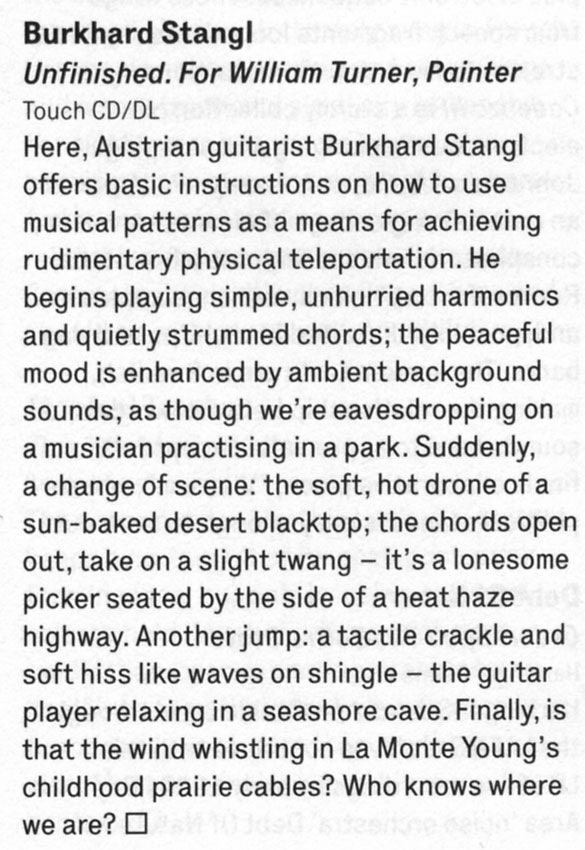
Brainwashed (USA):
Following a visit to the Tate Gallery and seeing JMW Turner’s paintings, Burkhard Stangl began working on a way to represent these painted landscapes as musical soundscapes. Focusing on Turner’s unfinished works, Stengl never truly gets into the same sphere as Turner. The resulting album is a collection of superficially nice music that has little below the surface, in opposition to the elegance and depth of Turner’s masterful compositions.
Every New Year in the National Gallery of Ireland in Dublin, a room is set aside to show a selection of Turner’s watercolors. Left by Henry Vaughan, he requested that they only be shown in January when the light was softest to do as little damage as possible to the delicate paintings. To this day, despite advances in artificial lighting, the gallery continues this tradition. This creates a sense of occasion and ceremony to the annual exhibition, the room feeling like a chapel dedicated to Turner where the works are viewed in a hushed atmosphere.
Stangl approaches Turner with a similar reverence and the music seems to be a soundtrack for such rapt and inward-facing contemplation. Using his guitar to create spacious and slowly evolving pieces, the music here is not unlike the approach that Dylan Carlson is employing in his drcarlsonalbion project. However, as with Carlson’s most recent work, Stangl’s playing does not really connect with me in any deep way. It sounds pretty but for the most part, the pieces (long pauses interspersed with small melodic units) feel contrived and lacking in emotion, as if the idea for the composition trumps the listening of the piece. Based on Stangl’s comments about the album, I am certain he is sincere in this tribute to Turner but his words seem at odds with the final form of the album.
During the first movement of “#1 Unfinished – Mellow; Waiting; Longing,” the lightly strummed guitar is joined by a recording of what seems to be children playing in the rain. Deliberately obscured, the field recording fades into the murk much like the landscape fades into the canvas in Turner’s work and is a nice nod to the painter’s style. However, by leaving the opening movement unresolved like the unfinished paintings that Stangl became enamoured with, it instead makes the music feel throwaway and unwanted. An unfinished painting has a mystery and a longing to it that is completely absent in “Mellow.” Especially given that it runs for about 15 minutes, about 12 minutes longer than it really should have.
Luckily, there is more to say about the second movement, “Waiting,” which also goes nowhere but in a beautiful, hazy way. The guitar sounds terrific, a pulsing tremolo and slight reverb bringing to mind Stangl’s work on Fennesz’s Venice combined with what sounds like an electric organ being played ever so softly. Here Stangl’s music comes closest to achieving the goal of approaching Turner’s style from a musical perspective. The final movement, “Longing,” follows the lead of “Waiting” yet never fully engages in the same way. Equally, “#2 Unfinished – Sailing” begins with a nice bit of playing but ends up going in circles for about quarter of an hour, leaving the air heavy with tedium. There is the momentary instance of a nice lick or resonance here and there though that is the best that can be said of the piece.
As if to highlight how unnecessarily long these pieces are, “#3 Unfinished – Ending” clocks in at just under three minutes and does everything that Stangl set out to do. Granted it is a lot busier than the previous pieces which might be contradictory to some notions of Turner’s work but here the guitar has both a soft, foggy presence with elements of sharp detail sticking out like gondolas on a misty Venetian canal. If Stangl had explored more in this direction, Unfinished. For William Turner, Painter would have been a much different, more effective album. [John Kealy]
France Musique (France):
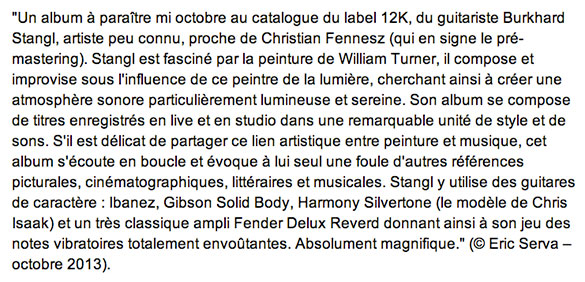
VITAL (Netherlands):
Something different is the Burckhard Stangl’s approach to music. Here we have nothing like thick drone sounds, but the electric guitar and tapes (electronics and field recordings). That’s it. All three pieces are inspired by the works of painter William Turner (1775-1851), that man of those great paintings of light, landscape and seasides. Stangl is especially overwhelmed (his own words) by the late and unfinished works and three pieces here were all recorded live, perhaps that’s a form of ‘unfinished’ for Stangl, being the opposite of a studio piece, being the ‘finished’ version? Whatever is the case, you hardly have the impression that you are playing a CD of live recordings. The guitar sound is very gentle, with an drone like undercurrent from time to time, but with more open ended strumming on top, and carefully mixed in field recordings and improvisational bits on top. It’s all very quiet, very atmospheric and very… light? I am not sure if that word ‘light’ would cover a similar meaning as the word ‘light’ for the work of Turner, but this is some excellent release. Beautiful, poetic music, with light touches to the guitar, and darker clouds occasionally above them. Great releases by Touch, both of them. [FdW]
kindamuzik (Netherlands):
Als je een beetje gevoel in je donder hebt, tetter je in een museum niet in je mobiel. Je rent ook niet als een malloot in de rondte of heft lallend een of ander lied aan. Dat doe je normaal gesproken ook niet. Zeker niet ten overstaan van de werken van de Britse schilder William Turner. Ook Burkhard Stangl werd daar meer dan stil van. Al helemaal toen hij in de Londense Tate oog in oog stond met de doeken die Turner op hogere leeftijd maakte.
Stangl was overweldigd door de kracht van de rust in Turners schilderijen; een sublieme, vrijwel fluïde kalmte, die voorbijgaat aan tast- of benoembare noties van licht en poëtische zeggingskracht. Daarin ligt een bijna bedrieglijke complexe eenvoud besloten. Stangl stelde zich ten doel die ongrijpbare aspecten van de sublieme, late en onafgemaakte werken van Turner te vangen in persoonlijke geluidslandschappen.
Unfinished. For William Turner, painter ademt meer op een kalmerende dan op een per se kalme manier. Stangl laat zijn elektrische gitaar galmen met subtiel vibrato en voegt er tactisch enige fieldrecordings en elektronische noten aan toe. Voorzichtig en geduldig, zoekend en ten slotte trefzeker in de finale overgeleverde compositie werkt Stangl met een toets die lichtvoetig is als water, licht en lucht tegelijk.
Onaf zijn de live-opnamen die Stangl presenteert zeker. Een volgende keer zou hij vast een of ander element anders aanzetten, foutjes maskeren, nieuwe wegen inslaan en wat dies meer zij. Onaf zijn ze ook doordat het sublieme niet aangeraakt wordt, maar in veel meer dan slechts suggestie wel present is: schitterend als door craquelé, terwijl hij het hele verhaal inclusief de clou net niet weggeeft. Onaf bovendien, vooral doordat Unfinished. For William Turner, painter je in stilte – al dan niet overrompeld, met opengevallen mond van ontroering – opneemt in een ervaring die zou kunnen raken aan het sublieme. Zo niet dan blijft Stangl – los van de associatie met de schilderkunst – verplichte kost voor iedereen die het werk van Christian Fennesz koestert. [Sven Schlijper]
RNE (Spain):
Burkhard Stangl es un compositor y músico austriaco, actualmente residente en Viena. En un principio, Stangl se centró en la guitarra y la electrónica y se convirtió en un prolífico artista en el mundo de la improvisación electroacústica.
Stangl ha participado en más de 50 grabaciones, la más notable es “Schnee”, un dueto con Cristof Kurzmann, inspirado en cuatro películas y una cita del escritor Robert Walser.
Su ópera del año 1997 “Der Venusmond” fue grabada parcialmente en la plataforma del Empire State Building.
Y ahora, que ya tenemos situados a este excepcional artista, llegamos al presente, porque tenemos su último disco inspirado y dedicado al pintor William Turner.
El disco es fruto de una de las visitas de Stangl a la galería británica Tate en el año 2003. Stangl quedó impresionado por los últimos trabajos inacabados del pintor, por el poder de la quietud de su obra. 25 años antes, Stangl experimentó algo similar en Madrid, con las obras de Goya en el Prado. Turner, como Goya una generación anterior, es uno de esos artistas cuyo lenguaje radicalizó el mundo de la pintura. Traspasado al mundo de la música, Turner es para Stangl a la pintura lo que Beethoven a la música.
Con el paso de los años, Stangl convirtió esta veneración en un placentero reto que le acercaba cada vez más al universo pictórico de Turner, a su compleja simplicidad, a la transformación de las atmósferas enigmáticas de sus obras tardías inacabadas en piezas musicales.
Escuchamos hoy la última pista de este disco, grabada por Philip Leitner en los estudios Garnison7 de Viena el 18 de junio de 2010.
DeBug (Germany):
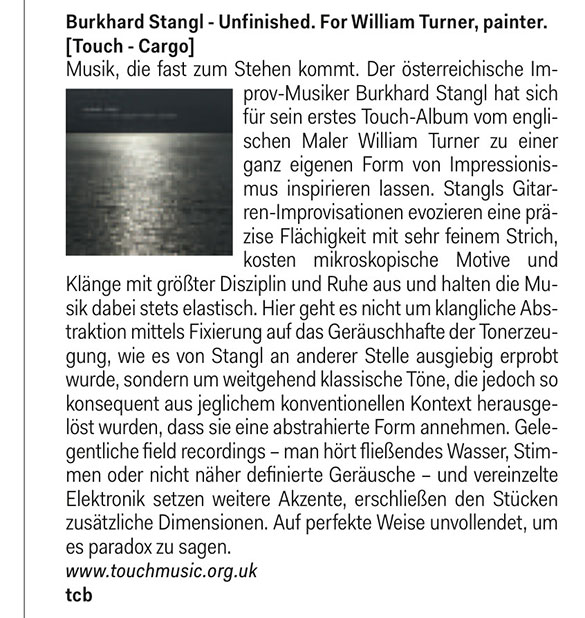
Musikansich (Germany):
Burkhard Stangl ist ein 1960 geborener Jazz und Avantgarde Musiker der sich inzwischen auch auf dem Feld des Field Recordings und der Klanginstallation betätigt.
Er hat seit Anfang dr 90er Jahre einige Aufnahmenveröffentlicht, viele davon in Zusammenarbeit mit den unterschiedlichsten Künstlern.
Unfinished. For William Turner – Painter, sein neustes Werk, hat er inspiriert von einer Ausstellung der Malers JMW Turner aufgenommen.
Eröffnet wird mit dem dreiteiligem Unfinished“, welches über 33 Minuten lang ist.
Ein elektronisches Grundrauschen erklingt, darüber spielt Burkhard Stangl eine schwebende elektrische Giterre in den klarsten Tönen. Es wird jede Note sehr langsam und intensiv ausgespielt. Es mischen sich dann die Fierecordings, in diesem Falle Wasserrauschen und Stimmen spielender Kinder darunter. So entsteht eine wunderschöne Atmosphäre, die man sich gut als Untermalung für schöne Bilder vorstellen kann, aber auch wunderbar für das eigene Kopfkino benutzen kann.
Das Gitarrenspiel verändert sich nur marginal, Stangl versteht es jedoch, mit geringfügigen Veränderungen und der Vermischung mit den Fieldrecordings den Hörer aufmerksam zu halten. “Part Two – Waiting“ startet nach knapp 11 Minuten mit einem dunklen, dröhnenden aber angenehmen elektronischen Ton. Darüber wird ein langsamer Akkord auf der E-Gitarre gelegt. Es mischen sich Geräusche hinzu und es entsteht eine sehr melancholisch-morbide Soundlandschaft, die den Hörer gefangen nimmt. Erinnert mich ein wenig an die langen Instrumentalpassagen des letzten Kate Bush Albums.
Der dritte Teil “Longing“ beginnt dann so ca. in Minute 26. Dieser besteht zuächst nur aus knarzenden elektronischen Geräuschen und Fieldrecordings, bevor eine verprenkelte Gitarre einsetzt, die dann jedoch wieder Klänge des ersten Teils aufnimmt.
Unter Einsatz der aufgezählten Elemente kreiert er ein sehr entspannende und doch zu entdeckende halbe Stunde Musik und Sound zu einem Ganzen zu verknüpfen. Die Gitarrenakkorde erinnern mich hier manchmal an die späten Talk Talk bzw. an das erste und einzige Soloalbum Mark Hollies.
Auch die beiden weiteren Stücken warten mit einer sehr feinen Verknüpfung von organischer Musik und Elektronik sowie den Tapes und Sounds auf.
Burkhard Stangl ist ein sehr angenehmes Album an der Grenze zwischen Klangkunst und Avantgarde gelungen das bei jedem Hören neue Facetten eröffnet, sich aber ebenso zum Entspannen hervorragend eignet. Auch ist es ein perfektes Einsteigeralbum in die Welt der Sounds, Geräusche und Avantgarde.
Freistil (Austria):
Alles auf dieser Stanglplatte, jedes noch so winzig kleine Detail, klingt wie aus einem Guss. Wobei Guss hier für die Gemeinschaft unabhängiger Sounds und Sinneswahrnehmungen zu stehen vermag. Singuläre Töne, Flagiolets, Akkorde, Intervalle, Melodiekürzel, sämtliche Sounds jeweils nackt oder mit viel Hall, sensible field recordings und electronics vom Band. Aus schwerer Arbeit wird hier leichte Kost zubereitet. Alles swingt vor lauter Soul, anders gesagt: Man wird bei der Beurteilung dieses Soloalbums von Burkhard Stangl beim besten Willen nicht ohne den Begriff der Schönheit das Auslangen finden. Das sogenannte Unvollendete macht der Wiener Gitarrist zum Thema, zum roten Faden durch schillerndes Monochrom. In Entsprechung zu den großen unvollendeten Werken der musikalischen Klassik bezieht unfinished sich auf einen Klassiker der bildenden Kunst, den Maler William Turner (1775-1851). In der Londoner Tate Gallery wurde Stangl von Turners radikalen letzten Arbeiten, die sich nur mehr mit den Elementen Licht, Luft und Wasser beschäftigen, laut eigener Aussage überwältigt. Überwältigt von der Poesie der Schlichtheit, gespeist und gewonnen aus alles umfassender Komplexität. Dieses Merkmal der Kunst alter Meister findet auf diesem opus magnum ihre Übertragung auf die Welt des Klangs, den ocean of sounds. Stangl schreibt ein Buch in drei Kapiteln. Das erste basiert auf der Komposition Mellow (My Feldman), komponiert für das Zither-Trio Greifer, und wird in eben mellow, waiting und longing unterteilt, sailing und ending heißen die assoziativen Titel der beiden weiteren. In diesem Prozess der Organisation von Klängen geht es um nichts weniger als das Verhältnis von Natur und Kunst, um die Welt als Wille und Vorstellung, um die Erschaffung und den Transport der Imagination. William Turners angeblich letzte Worte stellt Burkhard Stangl – als politscher Mensch selbstverständlich Agnostiker – dem von Luft und Licht durchfluteten Album als Motto voran: „The sun is God.“ Unvollendet in Vollendung. [felix]
Spex (Germany):

Blow Up (Italy):
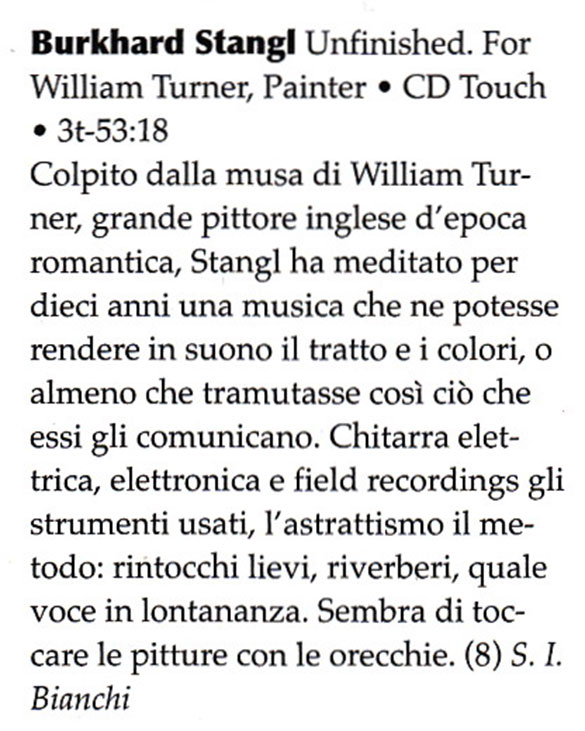
Carnage (Italy):
Successe un giorno a Londra, alla Tate Gallery in cui erano esposti i quadri di William Turner: l’illuminazione. Burkhard Stangl decide di dedicare la sua opere al pittore che ha trasceso le dimensioni del colore, della luce, dello spazio – “da notare che la stessa rivoluzione avveniva in musica. Turner è contemporaneo di Beethoven” -, ma che, non per questo inaccessibile. Anzi, Stangl ha cercato di avvicinarsi sempre di più alla semplicità del pittore per creare dei paesaggi sonori a lui dedicati.
Stangl si concentra sui suoni delle sorgenti a disposizione (chitarra, nastro e Mellow) per registrare dal vivo tracce costituite da movimenti, e ognuna con le specifiche di cosa è stato impiegato per realizzarla (strumento, marca, accordatura eventuale, interventi di editing o di mixing eventuali). La seconda traccia Unfinished – sailing, in compagnia di Fennesz, registrato nello studio Attman a Vienna in un solo take è davvero degno di nota. Come poter descrivere con le parole quello che a malapena un orecchio attento può percepire, o meglio, apprezzare? Gli elementi del disco non sono i suoni, ma i loro ricordi che riecheggiano, che passano all’orizzonte come navi inondate di luce – The Fighting Temeraire dovete sempre immaginarvela davanti a voi, in lontananza. [Riccardo Gorone]
SoundofMusic (Sweden):
Allt som är fast förflyktigas. Den brittiske målaren JMW Turner (1775-1851) räknas till de stora, kanske den störste, av de romantiska landskapsmålarna. Hans målningar (också många av akvarellerna) går inte att förbise, både med tanke på den originalitet och djupa inverkan de har haft i såväl dåtida som samtida måleri. Särskilt den senare perioden hos Turner är fascinerande, åren efter faderns död och hur han avbildar en värld, klivet in i det moderna och den industriella revolutionen, i en nästan termodynamisk upplösning. Med rätta har man här pekat ut de första tecknen på en abstrakt konst, något som Runge kunde skriva om men aldrig förmå att nå fram till visuellt.
Kanske är det därför typiskt, liksom fallet med till exempel Magritte, att vi idag gör det bästa för att förta magin genom att massproducera bilden och åka snålskjuts på dess estetiska inverkan. Det går inte ens att uppskatta hur många bokomslag inom allt från historia till skönlitteratur som prytts av Turner, liksom den fantasilösa normen att en bok i psykologi måste locka läsaren med Magritte. Personligen har jag ibland känt mig mäkta trött på Turner just på grund av denna stereotypa formgivning. Men har man bara sett målningarna live så går det inte att backa. Känslan är att det går att tillbringa ett liv framför dem.
Den österrikiske gitarristen Burkhard Stangl har nog haft en liknande upplevelse, som tillägnar sin nya cd till Turner och dessutom har den goda smaken att inte använda hans bilder vare sig på omslaget eller innanför pärmarna. Omslaget pryds istället av ett foto av Jon Wozencroft, som ofta jobbar för bolaget Touch. Det föreställer ett stilla hav utan blickpunkt, en yta som strävar långt ut mot en lätt rundande horisont. Havet är både inramat och potentiellt oändligt. Som bild är den rätt tråkig ärligt talat, men den ger uttryck för en stillhet som känns igen hos Turner och som återspeglas i Stangls musik.
Stangl behöver nog ingen närmare presentation, en veteran i det improviserade sammanhanget med en lång rad skivor i ryggen, inte sällan utgivna på det amerikanska bolaget Erstwhile, så som de hyllade samarbetena med Christof Kurzmann, Schnee (2000) och Neuschnee (2009). Att kalla musik ”stilla” är nog allt för svävande. Det kan betyda vad som helst, förutom det att det inte går särskilt vilt till. Men i Unfinished är det på sin plats, en så gott som ensam gitarr och lite elektronik som rör sig från klang till klang, mellan ackord och flageolett. I det första spåret, som är baserat på stycket ”Mellow (My Feldman)”, ursprungligen för tre cittror, hörs fältinspelningar av vatten och barnlek vagt i bakgrunden, kanske vid en fontän en varm sommardag. Att ”Unfinished I” knyter an till en tonsättare som också stod nära måleriet känns naturligt, men det väcker också frågor kring vad information gör med lyssnandet. Hör jag Turner? Hör jag Feldmans Rothko? Hör jag måleriska likheter eller musikaliska divergenser?
Men Stangl tonsätter inte ett måleri. Han låter sig inspireras, ett ord som är fullständigt utnött och egentligen bör undvikas. Men ordets härledning till latinets inspiratio ringar in skivans atmosfär, musiken andas Turner. Stangl fångar en stillhet som inte är vila, ett lugn som inte är overksamt. Denna dialektiska knut är inte lätt att beskriva. Men föreställ er en filmsekvens i ultrarapid, ett hus som rasar samman, helt stumt, utan ljud. Kubik efter kubik av betong uppgår sakta i ett moln av grus som i samma stund raderar konturerna av sitt forna tillstånd. Tänker ni er sedan att detta moln är en klang, ett ackord så har ni Stangl. Tänker ni er det som ett klimat har ni Turner. [Johan Redin]
Nowamuzyka (Poland):
Burkhard Stangl domalowuje kolejne sekwencje do niedokończonych obrazów Williama Turnera.
Przyznam, że nie znałem Stangla od tej strony. Na płycie „Unfinished. For William Turner, painter” pojawiło sie dużo spokoju i ciszy. Główną inspiracją dla austriackiego artysty są prace malarza Williama Turnera (1775 -1851). – W 2003, w Londynie w Tate Britain oraz Tate Gallery po raz pierwszy zobaczyłem na żywo obrazy Williama Turnera. Zostałem przytłoczony ilością jego niedokończonych prac i byłem pod wielkim wrażeniem ciszy, jaka wyłaniała się z jego prac – pisze Burkhard Stangl.
Niezwykły sposób ekspozycji prac Turnera prezentuje National Gallery w Dublinie. W okolicach Nowego Roku jedna z sal jest zarezerwowana, aby pokazać wybrane akwarele Turnera. Obrazy są wystawiane jedynie w styczniu, kiedy promienie słoneczne nie są jeszcze tak intensywne i nie spowodują dużego uszczerbku, a jest to możliwe w przypadku tak delikatnych obrazów. Do dnia dzisiejszego, pomimo postępów w kwestii sztucznego oświetlenia pomieszczeń muzealnych, galeria kontynuuje swoją tradycję. Dlatego ta forma prezentacji dostarcza widzowi wyjątkowo intymnej atmosfery, dzięki niej te niezwykłe obrazy nie są zblazowane halogenami czy tym podobnie oślepiającymi strumieniami sztucznych promieni. I właśnie taka jest muzyka Stangla, nie zaśmiecona, a przy tym brzmi niesamowicie intymnie.
Ciężko też uwierzyć, że kompozycje wypełniające album zostały nagrane na żywo w trzech różnych miejscach. Na krążku mamy dwa długie utwory i jeden krótszy. W całości swój materiał Stangl oparł o brzmienie gitary oraz eksperymenty z taśmami (elektronika i nagrania terenowe). Płytę otwiera „Unfinished (mellow, waiting, longing,)”, w którym gitarowe flażolety, przemieszane z pojedynczymi akordami wywołują poczucie wyobcowania i słuchacz jest świadom, że przez te kilkadziesiąt minut będzie miał możliwość dorysować kilka kresek do swoich własnych obrazów powstających pod powiekami. Wyjątkowo minimalistyczna elektronika z gęstym i usypiającym tłem.
Na pewno po longplay muszą sięgnąć miłośnicy Fennesza, nie ma w tym nic dziwnego, bo obaj muzycy znają się od 1980 r., kiedy to razem uczęszczali na wspólne wykłady z muzykologii i etnologii na Uniwersytecie w Wiedniu. Istotne jest to, że drugie nagranie „Unfinished – sailing” powstało właśnie w studiu Fennesza. Utwór został nagrany bez żadnych cięć i studyjnych zabiegów. Znowu to gitara Stangla okraszona delikatnym efektem delay, rozproszonym pośród odgłosów ptactwa, doprowadza mój umysł do stanu przyjemnej lekkości. Zaledwie trzy minutowe „Unfinished – ending” zamyka całość i na pewno nie jest to zamknięcie jakiejkolwiek z prac Turnera. Nagrania Stangla mogłyby trwać bez końca.
W istocie rzeczy otrzymaliśmy obrazy Turnera ubrane w dźwięki. Powstał swego rodzaju soundtrack do niedokończonych prac malarza. Stangl przygotował piękną, poetycką muzykę, z gitarą w ręku, z dużą porcją ciszy i spokoju, ukrytą pod wielowarstwową i przesiąkniętą dronami elektroniką, będącą świetnym podkładem dla intymnych i mrocznych dźwiękowych pejzaży Stangla. Myślę, że muzyka idealnie zabrzmiałaby właśnie w przestrzenie sali National Gallery w Dublinie, gdzie prace Turnera nabrałyby dodatkowego kolorytu, dzięki ciepłu płynącemu z gitary Stangla. [Łukasz Komła]
Sphere (France):
La scène autrichienne contemporaine a quelque chose de discret et d’omniprésent en même temps. Des musiciens comme le contrebassiste Werner Dafeldecker ou le guitariste Burkhard Stangl savent participer et collaborer avec des artistes qui ont tous des approches très différentes, sans être vraiment sur le devant de la scène. Burkhard Stangl, qui vient de sortir un solo en hommage au peintre Turner, fait partie de ces musiciens qui ont collaboré aussi bien avec Anthony Braxton, Taku Unami, Kevin Drumm, Robert Piotrowicz, Joëlle Léandre, Polwechsel et Christof Kurzmann, ce qui montre déjà l’étendue des esthétiques approchées par ce guitariste très influent pour les musiques improvisées et minimales actuelles.
Pour ce nouveau solo, Stangl adopte une approche très personnelle et intime de la musique. Je ne suis pas féru des associations entre la peinture et la musique, donc je ne vais tenter de faire des rapprochements entre le guitariste autrichien et le peintre anglais. Seulement, Stangl est apparemment une de ces personnes qui a été bouleversé par les derniers travaux du peintre, sur ces travaux où la peinture se présente pour elle-même, en tant que matière, avant d’être de la lumière ou quoique ce soit. Bref, Stangl joue ici une musique en hommage à un artiste qui l’a profondément ému, qui l’a bouleversé, d’où cette sensation persistante de proximité et d’intimité, d’émotions fortes et de présence.
Mais déjà, en soi, la musique de Stangl paraît facilement intime : car ce dernier joue seul, il joue sur ses guitares des arpèges épurés, aérés, des arpèges souvent nostalgiques, doux et mélancoliques. Un jeu de guitare pur axé sur les silences et les pauses qui ponctuent chaque arpège, mais aussi sur le dialogue avec des accompagnements réalisés sur cassette (field recordings d’ambiance – vent, eau, etc. – et noise très discrets, légers et atmosphériques). Unfinished est une magnifique suite de trois pièces (inégales en durée – de trois à trente minutes…) qui jouent principalement sur l’ambiance et l’atmosphère. On reconnaît ici et là des influences pop-folk car Stangl joue sur des Gibson, des Ibanez, un ampli Fender avec vibrato ; on reconnaît aussi l’influence de Sugimoto et du réductionnisme pour le jeu sur les silences, sur l’espace qui sépare chaque phrase mélodique et la réintégration des notes dans l’improvisation non-idiomatique. Mais Stangl va au-delà, il va dans la description et la peinture pures d’atmosphères sonores. Ce n’est pas qu’il s’intéresse au timbre ou aux textures, mais plutôt à l’ambiance sonore ressentie.
Et à ce niveau, ces compositions de Stangl sont merveilleuses. Les atmosphères sonores dépeintes par le guitariste sont lumineuses et simples, chaque attaque et chaque silence sont d’une intensité émotionnelle rare. Unfinished est un disque comme on en entend rarement : personnel et inventif ça l’est, émotionnel et évocateur ça l’est aussi, simple et riche, il l’est avant tout. Stangl, après ses passages dans la pop, l’électronique, le drone, le réductionnisme, l’improvisation non-idiomatique, réinvente sa musique en utilisant des éléments glanés au fil des années pour former une oeuvre cohérente et unique. Un hommage magnifique, oui Turner aurait de quoi être fier. Recommandé. [Julien Héraud]
Trust (Austria):
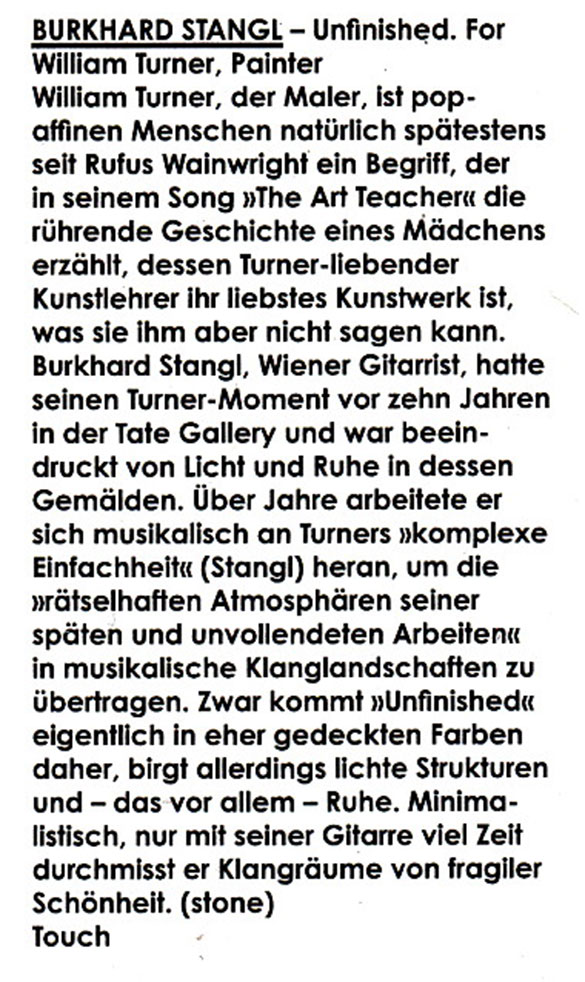
Bad Alchemy (Germany):
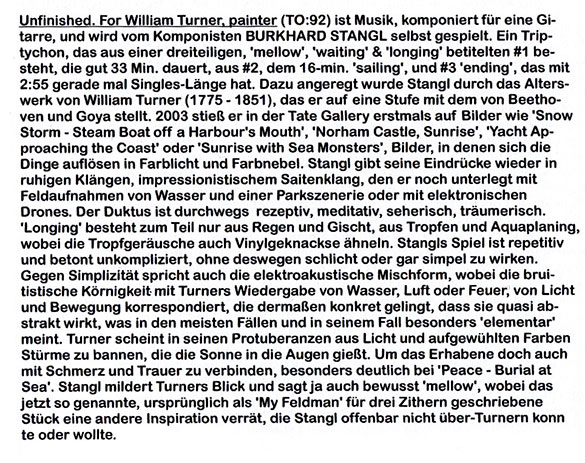
Ondarock (Italy):
Il chitarrista jazz-avanguardista austriaco Burkhard Paul Stangl rende omaggio al pittore romantico inglese William Turner con un disco di un’intensità strabiliante.
Affascinato soprattutto dalle sue tarde opere incompiute (le stesse che colpirono Monet in viaggio a Londra nel 1870), Stangl ha cercato di ricreare con i suoni della sua magnifica sei corde l’universo pre-impressionista del pittore inglese.
Solo tre le tracce in scaletta, ma la prima, un medley diviso in tre parti di ben 33 minuti, vale da sola l’acquisto del cd: nella prima parte, “mellow”, il chitarrista cesella lo spazio con la grazia di un orafo, definendo le coordinate con pochissimi tocchi; nella seconda parte, “Waiting”, Stangl costruisce un vero e proprio drone, capace di trasportare i neuroni tra i mille riverberi delle armoniche della sua chitarra; nella terza parte, “longing”, la più sperimentale, il chitarrista austriaco si lancia in un’improvvisazione talmente austera da sembrare una liturgia.
La seconda traccia dell’album, “Sailing”, è stata registrata da Fennesz nei suoi studi di Vienna e non presenta sovraincisioni né lavori di post-produzione: sedici minuti in cui rumori d’ambiente creano la camera d’eco per i lenti riverberi della sei corde dell’austriaco, in grado di far tremare ogni singola sinapsi. Più solare ma non meno intensa la breve chiosa di “Ending”, sorta di miraggio nel deserto tra le allucinazioni di Chas Smith e il classico “Paris Texas” di Ry Cooder. [Roberto Mandolini]
The Standard (Austria):
Die Lichtstimmungen des Proto-Impressionisten William Turner sind Musik, ein Universum kleinster Übergänge, gedeutet als “Jazz”. Funktionsharmonik ist bedeutungslos. Gitarrenmusik für die Verächter von Schäfchenwolken. [Roland Pohl]
Wiener Zeitung (Austria):
Burkhard Stangls wunderbare CD “Unfinished. For William Turner, Painter” (Touch) ist der gelungene Versuch, mit der E-Gitarre filigrane Klanglandschaften zu erzeugen, die auf die komplexe Simplizität der späten Gemälde von William Turner antworten. Dessen die Realität transzendierende, gleichsam nur aus Luft, Licht und Wasser komponierte Bilder hatte der Wiener Musiker erstmals 2003 in der Londoner Tate Gallery gesehen. Seitdem trat er mit der im Alter radikalisierten Malkunst des englischen Künstlers in einen Dialog, der ein gutes Jahrzehnt anhielt.
Das Ergebnis dieses Austauschs kann sich – auch dank des stimmungsvollen Albumdesigns – sowohl sehen als auch hören lassen. Stangl verlässt sich ganz auf seine Improvisationskünste an der Gitarre, um kontemplative Klänge zu erzeugen, die teils behutsam durch Field-Recordings und elektronische Geräusche ergänzt werden, woraus sich ein in seinen Klangfarben beständig changierendes Hörbild ergibt. Musik, die Bilder im Kopf hinterlässt. [ Uwe Schütte]
Revue et Corrigé (France):
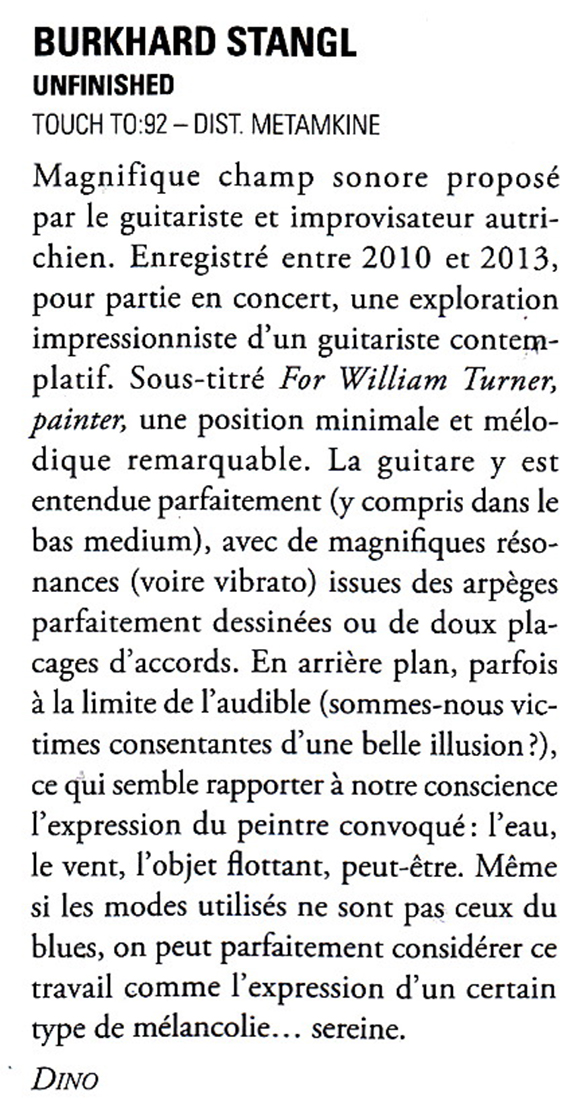
Hawai (Peru):
“Which side of the picture should be hung uppermost?”. Las imágenes que quedan en la etapa tardía de un artista pueden ser el reflejo de su desgano, de la pérdida de su interés por todo, como también puede ser la expulsión definitiva de su arte, el resumen y la conclusión de una vida intentando expresar lo que lo mueve en el interior más recóndito, lo más escondido de su persona. Un arrojo desprovisto de cualquier motivación que no sea vaciar su cuerpo en una obra. Como señala Sam Smiles, “la idea de que un artista de mayor edad está trabajando fundamentalmente para si mismo, ya no requiere más someter su visión al escrutinio público, o preocuparse por si es indiferente a la crítica. Si es así, el trabajo dejado en el estudio no está incompleto, sino que es un auténtico registro de la creatividad inflexible de un artista. Para algunos, realmente, es el último estilo el más puro”. Joseph Mallord William Turner fue un pintor romántico inglés nacido en Londres en 1775, muerto en la misma ciudad en diciembre de 1851. Sus cuadros capturaban de forma muy particular el paisaje, en óleos y también acuarelas. A pesar que esa etapa siempre me ha atraído, aunque desde un punto de vista muy lejano –aún quedan distancias enormes por recorrer–, nunca conocí su nombre hasta ahora, cuando sus colores difusos me llegan a través del sonido de la electricidad crepuscular de Burkhard Stangl. Las líneas de pintura que Turner trazaba sobre sus lienzos disgregaban las figuras y la luz que permitía distinguir sus formas, dejando rastros borrosos de ellas diseminados sobre la tela, especialmente en su etapa tardía, especialmente en sus obras incompletas, en el invierno de su vida separada.
Burkhard Paul Stangl, guitarrista austríaco de jazz nacido en 1960 en Eggenburg, cuya trayectoria está respaldaba por más de veinte trabajos, donde la improvisación se convierte en el método principal de sus composiciones. Esa creación libre lo ha llevado además ha colaborar con infinidad de músicos, gente como Max Nagl, Christof Kurzmann, Taku Sugimoto, Werner Dafeldecker, Christian Fennesz, Martin Siewert, David Sylvian, B. Fleischmann y Noël Akchoté, además de formar parte de diversos ensembles, entre ellos, Polwechsel. A pesar que, como se puede apreciar, su rastro es difícil de seguir, de todas formas es posible identificar sus señas. Con todo, este es recién su tercer trabajo en solitario, y el primero para la editorial inglesa, una impresionante inmersión en las notas interiores del ruido experimental, las armonías que crecen en la quietud que habita dentro de las cuerdas tensionadas. “Londres, 2003: la primera vez que visité el Tate Britain, la Galería Tate, y la primera vez que ví y realmente experimenté las pinturas de JMW Turner. Abrumado, especialmente por sus últimas e inacabadas obras estuve aturdido por el poder de la quietud de su trabajo. Veinticinco años antes algo similar; yo, como un joven en Madrid; Prado, pinturas y grabados de Goya, para mí una iniciación la cual abrió la puerta al arte antiguo y sus pioneros”. Del romanticismo al impresionismo, del movimiento impredecible a la tranquilidad y la contemplación reflexiva, “Unfinished. For William Turner, Painter.” establece relaciones entre el sonido y la imagen, tendiendo puentes que unen la soledad con su representación. Turner se fue aislando cada vez más, tanto física como personalmente. Y, como la mano no es diferente de lo que crea, sus pinturas se fueron alejando del resto, a veces solo manchas abstractas que apenas reflejaban el objeto personificado. La traslación de esas imágenes por parte del músico austríaco resulta en estos soundscapes, estigmas lanzados sobre el mar, a veces inmóvil, a veces inquieto, pero siempre sobre una superficie lineal de calma imprevisible. La etiqueta que identifica a este álbum habla de free improvisation, siempre y cuando entendamos por libre acordes estancados en el suelo extendido, y por improvisación observaciones aleatorias que se aproximan al silencio. Los medios para alcanzar estos estados de belleza pura serán básicamente dos: guitarra eléctrica y cintas (electronics + field recordings). De ellos naceran tres piezas que irán descendiendo en duración, tres descendentes en la profundidad exterior de un cuadro fijo a una pared vacía. “Unfinished – Mellow / Waiting / Longing” fue grabada en vivo por Norbert Benesch en Viena (Porgy and Bess) en enero 4 de 2013. Treinta y tres minutos divididos en tres partes donde desarrolla ampliamente su visión de aquello que observó en un muro blanco, eso que sostenía esos muros. ‘Mellow’ –basada en una composición de Stangl para tres cítaras, ‘Mellow (My Feldman)’– deja que el espacio que rodea a su guitarra fluya como si su presencia no fuese real, y su intervención se acomoda a él, dejando que el sonido se despliegue con respeto. Los acordes espontáneos son ejecutados con máxima sobriedad, como si en ese preciso instante estuviese mirando las pinturas del artista inglés.
Grabaciones de campo permiten escuchar voces distantes y agua, líquido que se escapa de las manos como los colores se escurren en las imágenes de Turner. Minuto once y un corte abrupto deja que se trasluzca el ruido de la electricidad, para que, un minuto después, las cuerdas comiencen a temblar cuando su mano se aleje de ellas. ‘Waiting’ y sus espectrales notas se esparcen con asombrosa hermosura, notas que se distancian unas de otras, dejando entre sí depresiones de inagotable belleza, alcanzando ciertos niveles y nitidez solo presentes en la obra de Loren MazzaCane Connors. ‘Longing’ introduce quiebres dentro de la composición pero, aún así, los límites no se rompen sino que se realza el sentido último de la misma. “Unfinished –Sailing” fue grabada por Fennesz –responsable además de la premasterización– en los Amann Studios en Viena el 5 de marzo. ‘First take, no edits, no cuts’. Similar a ‘Waiting’, los dieciséis minutos van transcurriendo con la serenidad habitual, con la guitarra sedada derramando los sonidos que se asientan cómodamente encima de la estática que produce la energía invisible, una luz permanente que traspasa los bordes que la separan. Ruido y brillo en la oscuridad, destellos intermitentes en la superficie erosionada por la electrónica orgánica, notas líquidas y espacios sin llenar. El eco que se produce alrededor del cuerpo de Stangl produce estertores infinitos. “Unfinished – Ending”, igualmente registrada en vivo por Philip Leitner –Garnison7, Viena, junio dieciocho de 2010– es el resplandor en el fin de esta extensión de los sonidos diseminados sobre el océano de colores indescriptibles.
“Como Goya, una generación antes que él, Turner es uno de esos artistas cuyo lenguaje se radicalizó en su edad final (en el campo de la música es contemporáneo a Beethoven). Sus cuadros tardíos trascienden la luz, llenos de imaginación poética, exquisita calma líquida. Pintura libre y pura, nada como luz, aire y agua. Cuando dejé la exposición se volvió claro para mí que esta visita fue el punto de partida para mi acercamiento musical a sus pinturas. Con el transcurso de los años fue un agradable cambio acercarme más y más a la compleja simplicidad del pintor, transformando las enigmáticas atmósferas de sus últimas e inacabadas obras en paisajes sonoros personales y atractivos”. Siento una enorme tranquilidad al contemplar estos sonidos, como al escuchar los cuadros de Turner. Esa calma permite poder apreciar los detalles infinitos que descansan en los movimientos generales de este trabajo. La hermosísima fotografía de Jon Wozencroft no hace más que acentuar el valor de esta obra de insondable belleza, la belleza crepuscular del ruido cromático y su melancólica luz eléctrica.
SKUG (Austria):
Seit fast 30 Jahren ist Burkhardt Stangl jetzt schon im »Geschäft«, was eigentlich nach einer fetten Jubiläumsfeier nächstes oder übernächstes Jahr schreit. Da würde dann wirklich alles kommen, was in der österreichischen Avantgarde- und Elektroakustik-Szene Rang und Namen hat, von den internationalen Namen gar nicht zu sprechen – sagen wir einfach nur Eugene Chadbourne, Jim O‘Rourke oder Steve Lacy. Mit Österreichs Vorzeigekomponistin Olga Neuwirth hat Stangl auch schon mehrmals zusammengearbeitet, und da wir schon beim eitlen namedropping sind, schreiben wir gleich auch noch Katharina Klement hin. Tolle Komponistin, aber wirklich wahr. Stangls neue CD »Unfinished. For William Turner, painter« ist aber eine Soloarbeit, eine Innerlichkeitsstudie im Zeichen von und als Hommage an William Turner, dem großen britischen Maler der Romantik. Da könnte man jetzt fragen: Avantgarde und Romantik, ja geht denn das zusammen? Stangl bezieht sich vor allem auf das unvollendete Spätwerk Turners, auf die enigmatische Atmosphäre und die nur scheinbare Einfachheit, verdichtet zu verflüssigten Schwebezuständen. Und das war im Prinzip auch schon eine Beschreibung des Hörerlebnisses. »Unfinished« erinnert in Ansätzen an den Soundtrack von Jim Jarmusch‘ »Dead Man«, den damals Neil Young einspielte, eine einzige, riesige Etüde mit schwebender Gitarre. Doch wo Young immer wieder zur Rockphrase zurückfand, da setzen bei Stangl dezente Elemente von field recordings ein, die das hingetupfte, schwebende Gitarrespiel noch mehr verwehen, noch ätherischer machen. »Unfinished« hat etwas von einer Meditationsübung in einer Tropfsteinhöhle, sehr entspannt anzuhören, ohne jedoch allzu leichtgewichtig zu werden. Eine Empfehlung, nona. [Curt Cuisine]
Goute Mes Disques (France):
On est toujours heureux de poser une oreille sur les publications de Touch Music. Non seulement parce qu’elles sont souvent l’œuvre de très grandes pointures (facile quand on se pointe avec un catalogue qui aligne Fennesz, Jana Winderen, Chris Watson, Biosphere, Phill Niblock et consorts), mais également parce que les nouveaux venus sont accueillis comme des seigneurs déjà adoubés (on se souvient de la claque prise avec l’arrivée de Sohrab). C’est donc avec une certaine excitation que l’on retire le film plastique qui entoure ce disque de Burkhard Stangl, convaincu que l’on tient là notre prochain objet sur lequel s’acharner, écoute après écoute. Burkhard est Autrichien, grand pote de Christian Fennesz (pour avoir participé notamment à Venice), et a publié, en vingt ans, des dizaines de captations sonores sur autant de labels microscopiques. Bref, un improvisateur au parcours classique, exagérément productif et excessivement difficile à retracer, tant historiquement que musicalement. Toujours est-il que cette fois, sur Touch Music, on risque de ne pas le rater.
On ne va pas faire de mystère, le travail de Burkhard Stangl oscille ici entre le bon et le dispensable. Pas de grand mystère donc, puisque le travail de Stangl ressemble de près à pas mal d’improvisations qui ont pu passer sur la table d’opération dans cette même pièce. Un homme, une guitare électrique jouée en arpèges et des machines posées à même le sol (histoire de générer autant de drone/ambient que de craquements et autres interférences). Un boulot langoureux et paisible (la première piste aligne trente-trois minutes d’improvisation) qui ne bouscule pas grand-chose à la première écoute. Les guitares jouées en arpèges sont d’ailleurs le grand classique de la prise de risque niveau zéro, il suffit alors de les habiller d’un peu de texture ambient/expé pour entrer dans le grand moule de l’œuvre molle de la bite, pas forcément fracassante, mais qui trouvera toujours son lot de défenseurs au sein de la ligue des intellos mal baisés (on le sait pour avoir été membre de cette ligue des années durant). Le tout, finalement, est d’éviter la médiocrité. Et en ceci Burkhard est bien trop fort pour se laisser prendre au piège, parvenant sans trop de mal à atteindre les standards minimums d’immersion et d’enrobage pour arriver en bonne place dans les charts hebdomadaires de sites de référence comme Boomkat.
Mais ne crachons pas dans la soupe, ce Unfinished – le disque s’inspirant des pièces inachevées du peintre romantique anglais William Turner – parvient à séduire gentiment, surtout quand les guitares se font moins présentes – où quand l’arrière-plan se fait plus présent, c’est selon. D’ailleurs, quand les guitares décident de fermer leur gueule définitivement, on assiste à un étalage d’une tristesse froide, les drones se chargeant d’imposer une cadence bien plus en adéquation avec un disque venu de chez Touch. Bref, on ne va pas vous emmerder plus longtemps, vous l’aurez compris, ce Unfinished possède les défauts de ses qualités, à savoir une immersion gentillette, un peu facile, qui remplit tous les codes de la bienséance ambient/modern classical. Le disque idéal pour lire un bouquin en faisant le dandy. [Simon]
le son du grisli (France):
Les épreuves sonores que Burkhard Stangl dédicace à William Turner – échos, voire répliques, de ses travaux non-finis : extraits de concerts et enregistrement studio confié à Fennesz – ne cachent pas longtemps leur attirance pour l’eau qui inspira souvent le peintre.
Les mouvements de la guitare électrique – médiator égrenant lentement les accords, volumes et rythmes changeants, sustains et trémolos, applications de notes sur de discrets field recordings ou enregistrements préparés – font bel effet sur les marines de Stangl. Non pas étale mais plutôt d’une huile patiemment remuée, son art rappelle (et, sur Unfinished – Mellow, s’inspire de) celui de Morton Feldman, lorsqu’il n’est pas attiré par la rumeur d’un navire qui croise au loin – à la barre, ce pourrait être Alan Licht ou Taku Sugimoto – et qui l’emmène dans des zones à sonder par la ritournelle.
Révélant là l’influence qu’exercèrent sur sa façon d’envisager sa musique la touche, la couleur et la lumière de William Turner, Burkhard Stangl démontre avec son modèle que la profondeur peut s’illustrer en surfaces, et même avec elles parfois ne plus faire qu’une. [Guillaumme Belhomme]
Artribune (Italy):
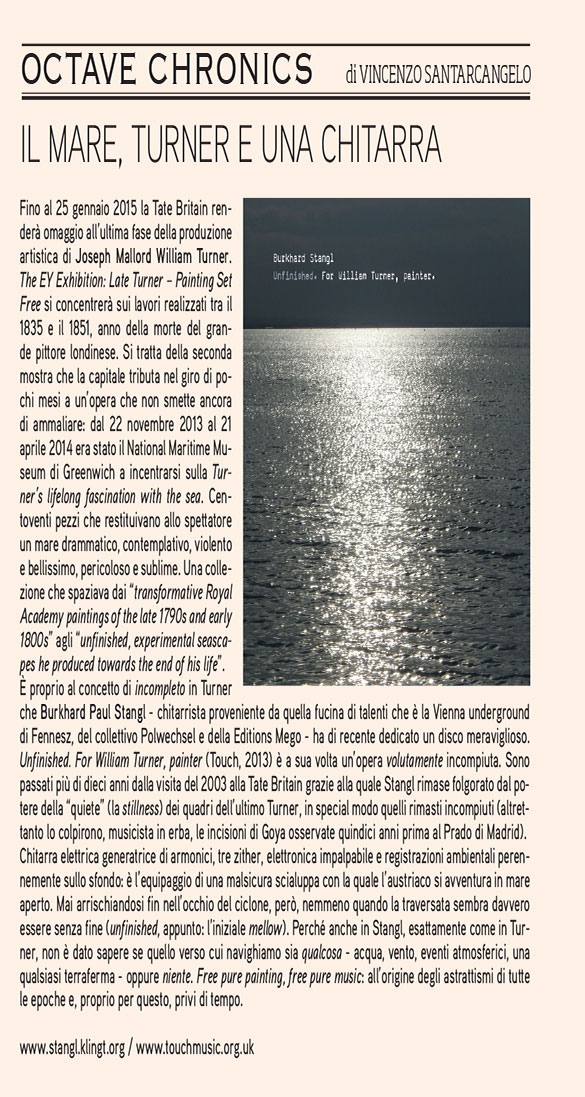
and










